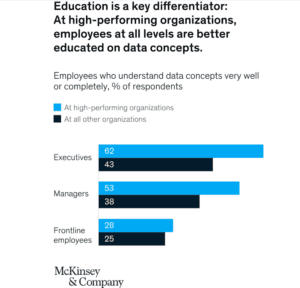Table of Contents
ToggleAs state superintendents refine their K-12 educational strategies to equip students with future-ready skills, there’s an unmistakable urgency to address the nuanced but essential difference between computer science education and data science learning requirements. The trend is clear: computational thinking has been anchored as a core skill within educational curricula, but as data becomes the new currency in a digital economy, the onus is on educational leaders to craft curricula that reflect this shift. Thus, introducing and emphasizing a data literacy curriculum for school districts is no longer a progressive addition to the academic menu but a critical imperative. Confounding the discussion is the recent emergence and unexpectedly robust coding capability of generative AI tools like Chat GPT and GitHub Co-Pilot. Is learning to write code still critical in an age where computers may soon write all the code for us?
Defining Data Science in the Context of K-12 Education
Defining data science for K-12 education requires an understanding that it stretches beyond the scope of computer science’s traditional boundaries. While computer science focuses on programming and technical fluency, data science dives into data collection, processing, analysis, and interpretation to inform decisions. A curriculum that marries the principles of both disciplines but distinguishes their applications is crucial. For example, while students might learn coding as a means to solve problems computationally in a computer science class, a data analytics curriculum program would guide them in applying those coding skills toward sifting through data, spotting trends, and drawing conclusions—fundamental steps in making informed business and scientific decisions.
To establish data science within the K-12 ecosystem, we must elucidate its components: the business and real-world use cases that drive its utilization, the statistical tools and theories that provide the foundation for making predictions (predictive analytics), the machine learning algorithms that power decision-making in complex scenarios, and the ethical implications surrounding data use. Instilling these components within K-12 education underpins a curriculum that is robust, forward-thinking, and inherently interdisciplinary, benefitting from the rich contextual application of mathematics, science, and social studies.
For those who have not already done so, as a primer in this subject, we encourage readers to examine in depth the GAISE II report published by the National Council of Teachers of Mathematics.
Rationale for Data Science Education in K-12
The advocacy for a data analytics curriculum program is supported by the market’s soaring demand for data proficiency. In a recent study by Burning Glass Technologies, jobs requiring data analysis skills are projected to remain among the fastest-growing sectors in the upcoming decade. (We have also spoken at length elsewhere in this blog about the need for data literacy and upskilling.) This demand signals the need for a systematic approach to cultivating data literacy from an early age. In terms of personal development, data science equips students with the acumen to dissect complex information, nurturing critical thinking and evidence-based reasoning skills. 
Educationally, creating a data literacy curriculum for school districts can elevate the traditional learning paradigm. It transitions students from mere technology users to architects of new solutions leveraging big data. By doing so, states ensure their students are prepared for higher education and position themselves as cultivators of a technically proficient and analytically minded workforce, ultimately contributing to statewide economic growth and social progress.
Overlapping Competencies: Where Computer Science and Data Science Meet
The integration of data science and computer science within K-12 education does not necessitate an overhaul of existing curricula but rather a strategic alignment to ensure that students benefit from a coherent, comprehensive learning journey. Foundational skills like logic formulation, algorithm development, and systematic problem-solving serve as the bedrock for both computer science and data science disciplines. Creating a data analytics curriculum program requires this foundation, but it also necessitates an appreciation for how data science extends these competencies into the realm of statistical inference, pattern recognition, and the interpretation of large data sets.
Data science education, therefore, can begin where computer science education reaches its practical application stage. Students who can code may start performing data analysis on real-world data, thus understanding the relevance and application of their coding skills. These overlapping competencies enable educators to devise modules that teach core principles in algorithmic thinking while simultaneously applying these concepts to data-driven inquiries and projects, thereby solidifying the connection between theoretical knowledge and real-world application.
The Pros and Cons of Standalone Data Science Standards
The articulation of a distinct set of learning standards for data science yields several advantages. It enables educators to develop specialized programs that address the specific needs of data science education, ensuring that students receive tailored instruction in this domain. Moreover, it delineates clear educational pathways and competencies that can guide curriculum development, pedagogy, and assessment. However, creating a standalone data analytics curriculum program also presents challenges. Superintendents must carefully consider the ramifications of duplicating efforts in computer science education and manage the practical aspects of introducing another layer of curriculum standards, such as the reallocation of funding, potential curriculum bloat, and ensuring that educators are sufficiently prepared to deliver new content.
Yet, the adoption of a separate data science standard should not be viewed through a lens of ‘addition’ but rather ‘integration.’ This approach emphasizes enhancing existing structures with data science modules that reflect both the depth and breadth required for data competency. It necessitates a careful balancing act: incorporating essential data science elements without overwhelming the curriculum or educators, all while aiming for the seamless fusion of data literacy into existing educational narratives. QuantHub’s K-12 training platform, for instance, addresses this nuance by offering educators the ability to select skills at a granular level, and then easily incorporate them into existing classes like mathematics, science, and CTE.
Best Practices for Developing Data Science Standards
The creation of K-12 data science standards should involve a multi-pronged approach. Engaging with educators who understand the nuances of curriculum development is as important as consulting with data professionals who can provide industry perspective, ensuring that the curriculum remains relevant and anticipates future trends. Educational standards must also be adaptive, scaffolded to support students as they progress through different stages of complexity in understanding data science concepts. A review of global best practices reveals that standards which are too rigid can stifle innovation, whereas those built with flexibility in mind can adapt to the changing educational landscape and technological advancements.
Education leaders aiming to implement data science standards should also look to leverage partnerships with higher education institutions and private sector organizations to ensure the curriculum not only meets the academic rigor required but also the practical, hands-on experience that students need. These relationships can yield insights into the types of data science skills that are most valuable in the current and future job markets and can ensure that the curriculum prepares students for higher education and beyond.
Implementing Data Literacy Curriculum for School Districts
The journey to a comprehensive data science curriculum begins with pilot programs that identify the curriculum’s strengths and opportunities. Alabama, for example, partnered with QuantHub to roll out such a pilot program across 16 schools in 2022. This program’s success ultimately provided clear opportunities for iteration and expansion while also highlighting many nuanced challenges in weaving a data science curriculum into existing course offerings. Early learnings from the pilot that were implemented in the broader roll-out spanned from SIS interoperability (addressed in OneRoster Compliance by 1EdTech) to ensuring equity for students in rural areas with limited access to high speed internet. (This three-minute video summarizes the impact the program is already having.)
Such initiatives provide a roadmap for broader implementation, allowing for careful adjustment before statewide rollout. Professional development is critical in this regard; educators must be equipped with not only the knowledge but also the confidence to teach complex data science concepts. In the Alabama pilot, educators themselves are encouraged to participate in the training program, and are awarded professional development credit upon completion of a core set of modules. (Since QuantHub is adaptive, each learner receives a learning journey that quickly adapts to their skill strength, enabling teachers and students to be challenged simultaneously.)
Community engagement is also paramount, as feedback from students, parents, and educational stakeholders can inform the iterative improvement of the curriculum, ensuring that it stays relevant and effective. In Alabama, the QuantHub team addressed this by hosting numerous focus groups and listening sessions across the states with administrators and teachers. Feedback from focus groups and surveys from a broad swath of the community can be critical in better understanding the unique needs of the learners, educators, and ultimate industry partners. Moreover, this evidence base can become a powerful tool in advocating for the necessary investments to scale data science education across districts and schools.
Conclusion
As stewards of education, superintendents face the unique challenge of pioneering curricula that reconcile the demand for digital fluency with the imperative for data literacy. The decision to embark on the development of standalone data science standards is multifaceted and consequential, as it seeks to empower students not just with the knowledge of data collection and analysis, but with the transformative ability to apply this knowledge in solving complex, real-world problems. Adapting computer science courses is a step in the right direction, but risks missing the larger arc of technological change that is unfolding before us.
Investment in a data literacy curriculum program for school districts is an investment in the state’s future, promising to cultivate a workforce adept at navigating and leveraging the data-centric landscape of tomorrow’s economy and society.
QuantHub has leveraged the latest in artificial intelligence technology to build a platform that teaches data skills alongside teachers in traditional classes like math and science. To learn more about building data literacy into your curriculum, or how this revolutionary program can help your school district teach critical data skills, schedule an appointment with the team at QuantHub today.
For Further Reading on Data Literacy Curriculum for School Districts:
-
- Alabama Course of Study – Digital Literacy and Computer Science
- Data Science for Everyone
- Forbes: Big Benefits Of Prioritizing Big Data In Education
- Maryland K-12 Computer Science Standards
- New York State – Education and Digital Fluency
- Virginia Computer Science Standards
- Virginia Computer Science Standards of Learning

